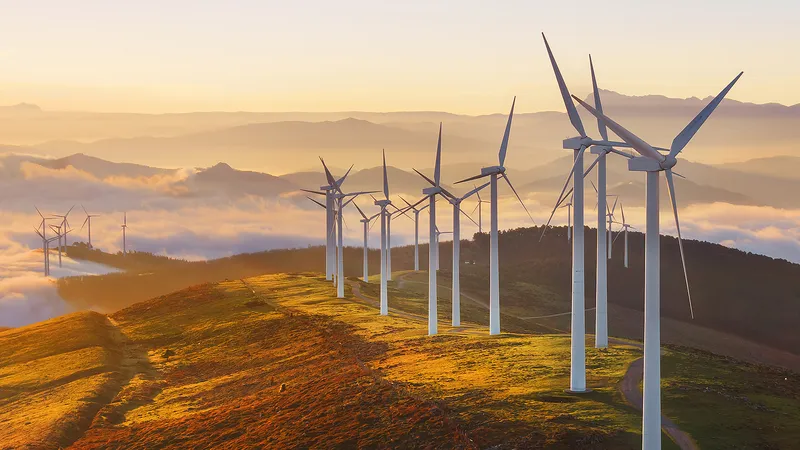Empowering Tomorrow: Unleashing the Potential of Renewable Energy for a Sustainable Future

Renewable energy is rapidly advancing, driven by innovation that lowers costs and fulfills the promise of a cleaner energy future. In the U.S., solar and wind power are breaking records and seamlessly integrating into the national electricity grid, maintaining reliability.
This shift means renewables are increasingly replacing fossil fuels, which are known for higher emissions of carbon and other pollutants. However, not all energy sources labeled as “renewable” are environmentally friendly. Biomass and large hydroelectric dams present significant trade-offs, impacting wildlife, climate change, and other factors. Here’s a closer look at various renewable energy sources and how you can leverage these technologies at home.
What is Renewable Energy?
Renewable energy, or clean energy, originates from natural sources or processes that are constantly replenished. Sunlight and wind, for example, are naturally recurring, even though their availability can vary with time and weather.
Historically, humans have harnessed nature’s energy for heating, transportation, and lighting. Wind-powered boats and windmills, while the sun provided warmth and helped start fires. Over the past 500 years, however, we increasingly turned to cheaper, more polluting energy sources like coal and fracked gas.
Today, innovations in capturing and storing wind and solar energy are making renewables a more significant power source, contributing over 12% of U.S. energy generation. This growth spans from large offshore wind farms to rooftop solar panels, even enabling entire rural communities to rely on renewable energy for heating and lighting.
A key future goal is modernizing America’s electricity grid to be smarter, more secure, and better integrated across regions.

Dirty Energy
Nonrenewable, or “dirty,” energy sources include fossil fuels such as oil, gas, and coal, which are limited in availability. For example, the gasoline we use comes from refined crude oil that dates back to prehistoric times.
These nonrenewable sources are often concentrated in specific regions, making them more abundant in some countries. In contrast, every country can harness sunlight and wind. Prioritizing renewables enhances national security by reducing dependence on fossil fuel imports.
Fossil fuels also pose significant environmental and health risks. Oil drilling can lead to deforestation, fracking can cause earthquakes and water pollution, and coal power plants pollute the air. All these activities contribute to global warming.
Types of Renewable Energy Sources
Solar Energy
Humans have used solar energy for thousands of years to grow crops, stay warm, and dry food. According to the National Renewable Energy Laboratory, the energy from the sun that hits the earth in one hour exceeds the world’s annual energy usage. Today, we utilize solar energy to heat homes and water, and to power devices.
Solar cells, typically made from silicon, convert sunlight directly into electricity. Distributed solar systems can power homes and businesses locally through rooftop panels or community projects. Solar farms can generate electricity for thousands of homes, and floating solar farms utilize bodies of water efficiently.
Solar energy accounts for nearly 3% of U.S. electricity generation, with projections to reach 4% soon. Solar systems produce no air pollutants or greenhouse gases, and their environmental impact is minimal beyond the manufacturing process.
Wind Energy
Modern wind turbines, as tall as skyscrapers, generate electricity by converting wind into mechanical power. Wind energy accounts for 9.2% of U.S. electricity generation and is one of the cheapest energy sources in the country. Wind power is prominent in states like California, Iowa, Kansas, Oklahoma, and Texas, but turbines can be placed in any area with high wind speeds, including offshore.

Other Alternative Energy Sources
Hydroelectric Power
Hydropower, the largest U.S. renewable energy source, relies on fast-moving or descending water to generate electricity. Large hydroelectric plants, or mega-dams, are often considered nonrenewable due to their environmental impact. Smaller hydroelectric plants, with capacities below 40 megawatts, cause less damage by diverting only a fraction of water flow.
Biomass Energy
Biomass includes organic materials from plants and animals, like crops and waste wood. Burning biomass releases chemical energy as heat, which can generate electricity. While often marketed as clean, some forms of biomass, particularly from forests, can produce higher carbon emissions than fossil fuels. However, using by-products like sawdust from sawmills can be a low-carbon option.
Geothermal Energy
Geothermal energy harnesses the earth’s internal heat, brought to the surface via deep wells. This hot water drives turbines to generate electricity. Geothermal plants typically have low emissions if the steam and water are reinjected into the earth. However, creating geothermal plants in areas without natural reservoirs may increase earthquake risk.
Ocean Energy
Tidal and wave energy, still in development, offer potential due to the constant motion of the ocean driven by the moon’s gravity. Tidal barrages and wave devices can harness this power but may impact marine wildlife.
Renewable Energy in the Home
Solar Power
At the home level, solar energy can power an entire house using photovoltaic panels or passive solar designs that capture and store the sun’s heat. Some homes generate excess electricity, which can be sold back to the grid. Solar batteries provide storage for use at night, and innovations like solar windows and shingles are emerging.
Geothermal Heat Pumps
Geothermal heat pumps use the earth’s constant temperature to heat and cool homes efficiently. Although expensive to install, they are cost-effective in the long run, quieter, require less maintenance, and last longer than traditional systems.
Small Wind Systems
Homeowners can install small wind turbines to reduce dependence on the grid. These systems are suitable for areas with sufficient wind speeds and can significantly cut electricity costs.

Selling the Energy You Collect
Homes with wind and solar systems can connect to the grid, and many states allow net metering, where homeowners only pay for the net electricity consumed by the grid. Excess electricity can be sold back to the utility provider at retail rates, offering a potential income stream.
Renewable energy is transforming the power landscape, offering cleaner, sustainable alternatives to fossil fuels and enabling homeowners to contribute to a greener future.



